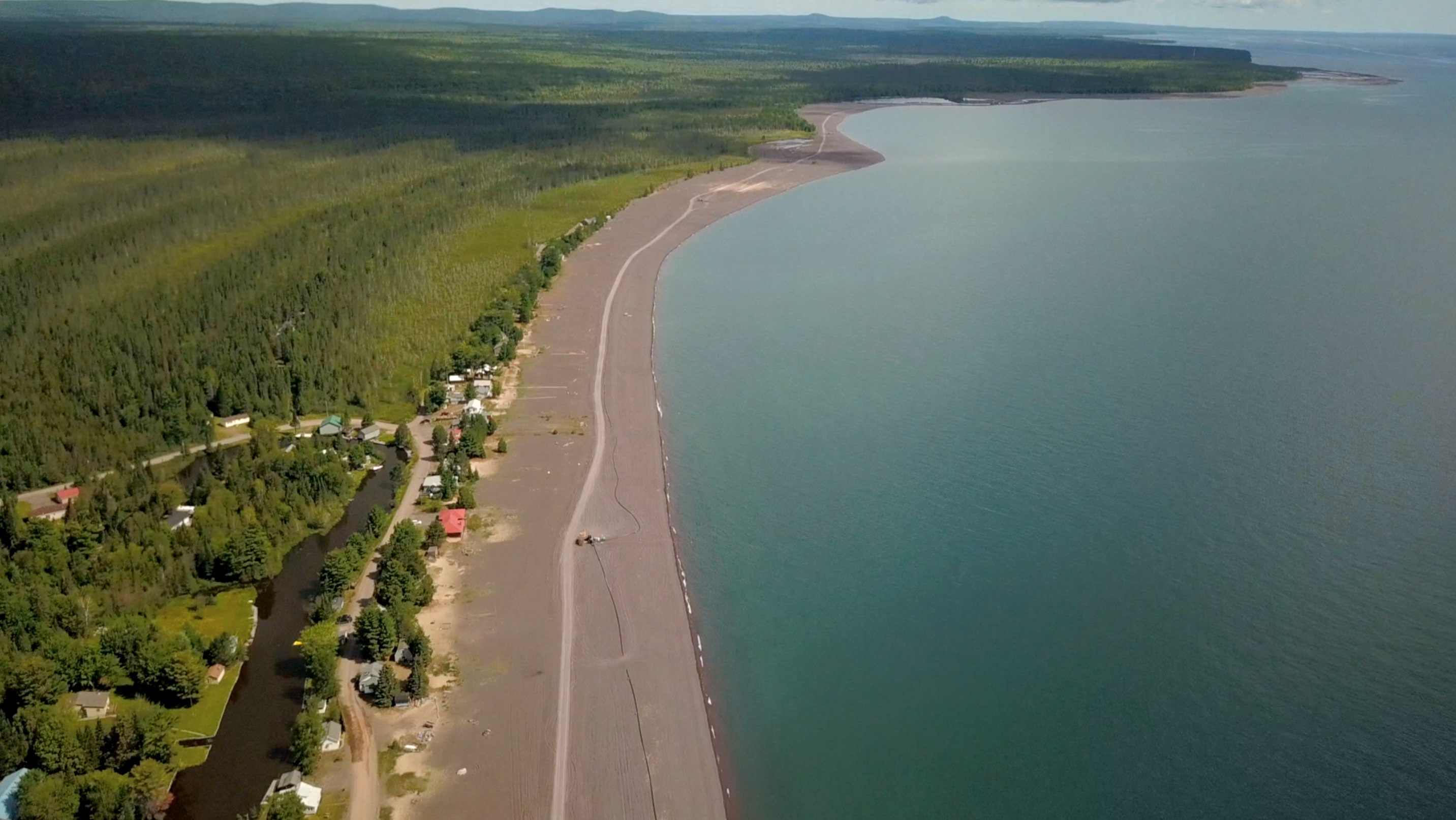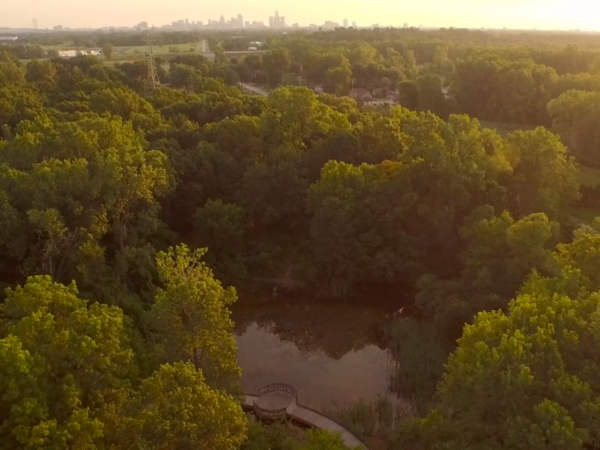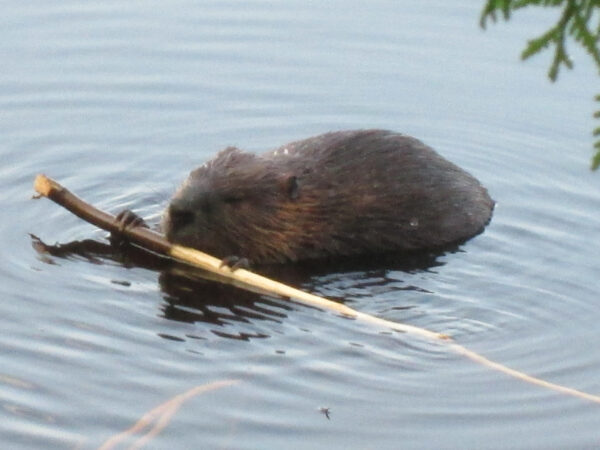
As the U.S. EPA prepares to expand its Great Lakes Restoration Initiative with the $1 billion-dollar windfall from the infrastructure bill, Ojibwe Tribal executive Michael “Mic” Isham has a vision to bolster the program.
Isham wants an increased emphasis on protection of the Great Lakes with a priority for Lake Superior, which Isham says is the “cultural and historic center” of the Ojibwe tribes.
While not opposed to restoration, Isham said he strongly believes in protection, and he wants that increased focus to help stem degradation of Lake Superior, which he says is ongoing and is threatening the lake with “death by 1,000 cuts.”
Isham is executive director of the Great Lakes Indian Fish and Wildlife Commission, representing 11 Ojibwe Tribes in Minnesota, Wisconsin and Michigan. He made his remarks to a Great Lakes restoration workshop for environmental journalists sponsored by the non-profit Institute for Journalism & Natural Resources.
He called for the U.S. EPA, overseer of the restoration initiative, to incorporate “protection” into the title of the program, making it the Great Lakes Restoration and Protection Initiative. He also wants increased flexibility in GLRI to address cleanup areas that may not be eligible for restoration funding.
Outsized reliance on metrics
Isham praised GLRI, especially in its early days, for providing capacity funding that allowed the Tribes to be present as the program developed. He also served on a formal advisory board that made recommendations to the EPA on restoration, which gave him a seat at the table as action plans were developed.
But he cited the initiative’s outsized reliance on metrics to demonstrate results as a barrier for the Tribes to overcome when seeking funding.
Metrics – like acres of habitat restored or the number of cubic yards of toxic sediment removed – drive the programs and were presented to Congress to justify funding. Isham said tribal projects tend to incorporate Seventh Generation principles and traditional ecological knowledge that don’t easily produce short-term results but are no less worthy.
To address the Tribes’ concerns, in 2020 Congress directed creation of a specific initiative, Distinct Tribal Programming, “to support Tribal priorities that are consistent with GLRI goals and objectives.”
DTP has provided opportunities for Tribes to secure funding that may have not been available, Great Lakes Indian Fish and Wildlife Commission policy analyst Jen Vanator told Great Lakes Now.
The program allows Tribes to submit proposals for “holistic programs that directly address the priorities of their communities,” Vanator said. But while DTP is helpful, it’s not total relief from metric reporting, according to Vanator, who said the Tribes are not alone in their concern.
“Many of our state agency partners that we work closely with in the Lake Superior basin are very worried about degradation of Lake Superior ecosystems – especially in the face of climate change – and have been working with us to try to come up with metrics that can link protection activities to the GLRI that can potentially make it into the next Action Plan,” Vanator said.
An example Vanator cited in the need for more flexibility in the program is the Buffalo Reef area of the Keweenaw Peninsula which is plagued with copper mine tailings.
Vanator said the degradation at areas like Buffalo Reef are “significantly impacting the health of the Lake Superior ecosystem,” but because they are not on the EPA’s Area of Concern list, they are not eligible for restoration funding.
“The problem is well-documented, solutions have been formulated, but the price tag makes the EPA balk,” Vanator said.
Michigan Technical University professor and environmental historian Nancy Langston agrees with the Tribes on the need for an increased emphasis on prevention and additional flexibility in the program.
Langston said she understands the importance of metrics needed to secure bipartisan support for GLRI from Congress.
“But at times this can reduce the chance for funding other projects of equal importance that are less shovel-ready and might have more difficulty quantifying results. I would like to see more emphasis on prevention of future environmental cleanups, and protection of key habitats before they become degraded,” Langston said, adding, “It’s always far, far cheaper to prevent toxic waste than to clean it up decades later.”
Original toxic site list remains the priority
As a non-profit advocate, Chicago-based consultant Cameron Davis lobbied for Great Lakes restoration in Washington and in 2009 was appointed to coordinate GLRI in the Obama administration EPA when implementation began.
Davis told Great Lakes Now the first priority should continue cleanup of the Areas of Concern on the original list but acknowledged the need to deal with toxic sites like Buffalo Reef.
“There are a lot of places around the Great Lakes that could have been AOCs but didn’t make the list,” Davis said. He cited the number of sites as the barrier.
Davis recommends that EPA incorporate non-AOC sites into a future restoration plan.
The EPA acknowledged the needs of the toxic areas that are not AOCs but echoed Davis’ sentiment that the primary emphasis should be on the AOCs identified by the U.S. and Canada that remain on the original 1987 list.
EPA spokesperson Taylor Gillespie told Great Lakes Now that the agency has funded some non-AOC toxic site cleanup and cited Buffalo Reef as an example.
“We are certainly aware of Buffalo Reef and the difficult issues there, and EPA has been actively participating in the Buffalo Reef Task Force for several years. While Buffalo Reef is not an AOC, approximately $9 million of GLRI money has been directed towards this site to remove stamp sands from Grand Traverse Harbor and a trough near the reef,” Gillespie said.
On engaging the Tribal governments on traditional ecological knowledge and the Distinct Tribal Program, Taylor said “EPA has worked very closely with the Bureau of Indian Affairs and the Great Lakes Tribal governments to develop a Distinct Tribal Program under the GLRI.”
The program states the agencies involved in GLRI will “work with Tribal governments in the spirit of self-determination, maximum flexibility, and consistent with federal Indian trust responsibilities to support Tribal priorities that are consistent with GLRI goals and objectives,” Gillespie said.
Gillespie said in fiscal year 2020 the GLRI supported approximately 70 Tribal projects with an estimated $12 million.
On other GLRI issues, Gillespie said the EPA plans to release its roadmap to accelerate the cleanup and delisting of AOCs using funding from the infrastructure bill within a month.
She said the cost to cleanup and delist the AOCs could be as much as $2 billion.
The Detroit River AOC still contains approximately 3.5 million cubic yards of toxic sediment, and Gillespie said the estimated cost to remove the sediment, restore habitat and do evaluations is between $100 and $200 million.
Previously, EPA has said removal of the toxic sediment in the river is on track to be completed by 2030. Michigan’s Department of Environment, Great Lakes and Energy AOC manager Rick Hobrla told Great Lakes Now that the EPA’s 2030 date is “highly optimistic.”
Dealing with contaminated sediment remediation is complex and “there are a lot more things that can go wrong than there are things that can go right,” Hobrla said.
Catch more news at Great Lakes Now:
Your Federal Tax Dollars: How they are funding the Great Lakes Restoration Initiative
Q&A: New EPA Great Lakes administrator talks Benton Harbor, infrastructure, AOC cleanup
Featured image: Lake Superior shoreline off Michigan’s Upper Peninsula (Great Lakes Now Episode 1006)
2 Comments
-
To tell the truth, I absolutely support the policy of Ojibwe Tribal executive Michael “Mic” and I think that he offers up absolutely reasonable ideas which will help stem degradation of Lake Superior. Of course, it is really important to pay attention to such a valuable object of nature which requires a great deal of protection and preservation. Without any doubts, different factors can affect the condition of the lake and the health of its ecosystem. I think that it is really important to take them into account in order to change the situation and open new opportunities for the improvement of Lake Superior. From my point of view, removal of the toxic sediment in the river needs to have a paramount importance because this problem is truly considerable and these toxic sediments can entail really negative consequences, leading to a high level of danger.
-
Great article. Thanks




